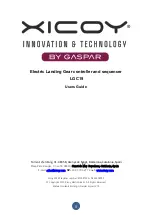
5
On the left side there are the RC connections.
Gear In: This is the main input for the RC power and commands.
It gives power to run the internal processor and display. The internal processor accepts
up to 9V.
The RC commands on this input would depend on the mode used:
-
Normal servo mode, dual channel:
This input will control the deployment of the gear.
Brakes will be controlle
d by the command received on “Brake In” input.
-
Normal servo mode, single channel:
Gear deployment and brakes will be controlled
by this input; signa
l present on “Brake In” input will not be used.
-BUS Mode:
Connect here the SBUS/XBUS/UDI/SRXL/EXBUS/P2BUS/MPX/JR Mode A/B
from the RX. The commands for Gear, Brake and steering will be extracted from the
appropriate channels on the decoded bus protocol. All the channels are user selected,
head to Radio for further information.
Brake In: Input for the brake command when dual channel mode is used.
Out 1 … 8:
Outputs for the 8 servos to operate the doors. The power for these servos
will come from the
main battery through its dedicated switching regulator.
Steer In: Command input for the steering servo when
Normal Servo mode
is used.
Signal could come from a dedicated receiver outp
ut or through a “Y” lead from rudder
channel. Center and sense of movement can be adjusted, to allow adjusting the travel
and center of the steering servo without influencing the rudder.
Steer Out: Output for the steering servo. Signal is processed, according to the center,
gain and gyro mixes when the gear is deployed, and centered during retraction.
Note: The power for the steering servo comes from the
Steer In
input, to allow using
different voltages. In the case of using BUS input, a patch lead should be connected
between the Steer In to the
Brake In
connectors to supply power to steering servo.


















